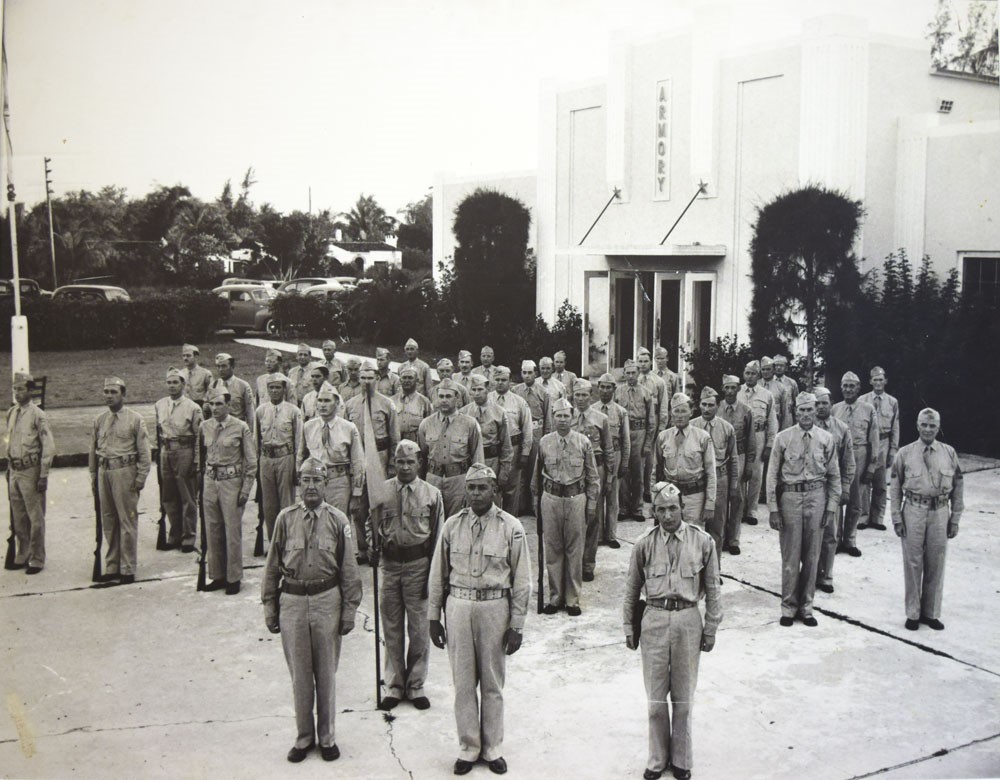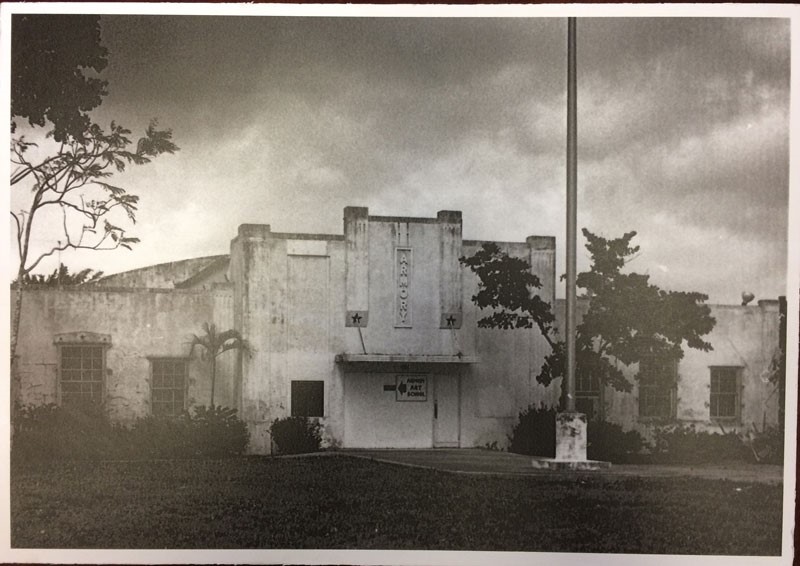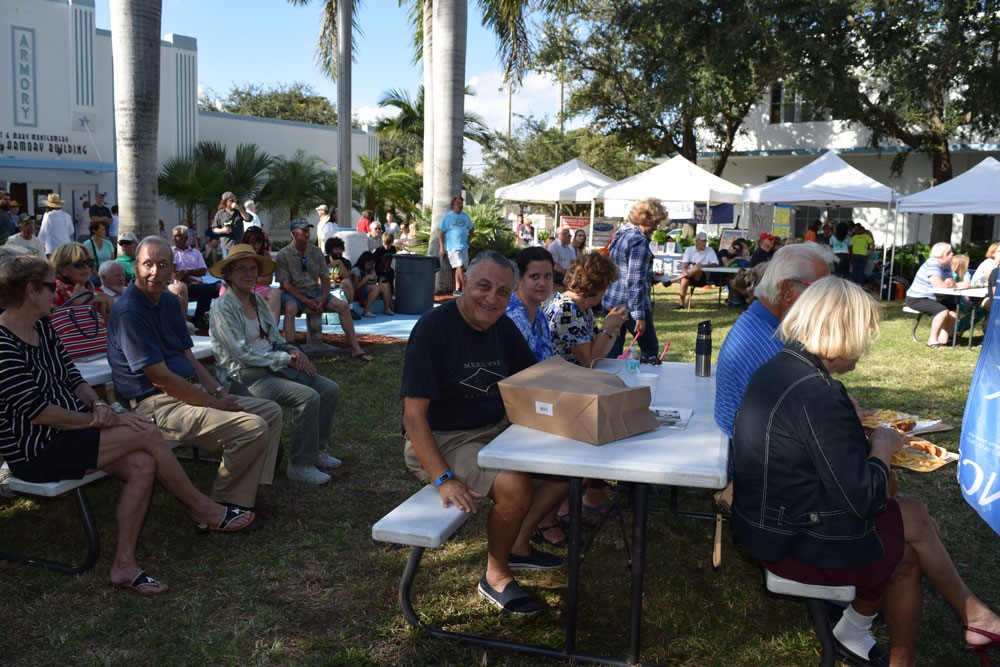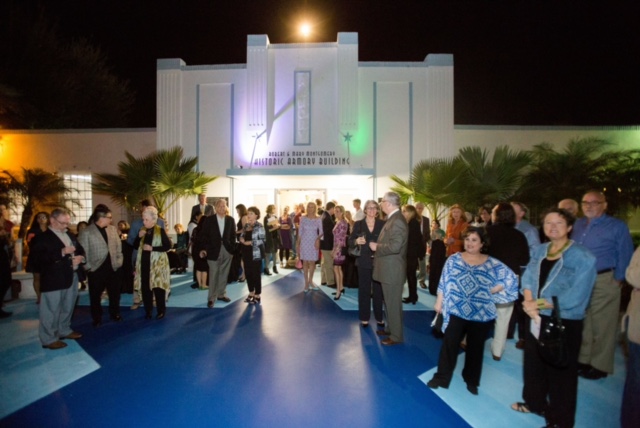The story of the Armory Art Center mirrors America’s progression of history from the early twentieth century into the twenty-first. As the United States moved away from being primarily a rural/agrarian country, struggled to find a way out of the Great Depression, fought through World War II, dealt with post-war damage and reconstruction, developed new ideas to reinvent itself, and emerged as an economically and artistically vibrant urban society, so the Armory progressed, every step of the way.
FROM THE FARMLAND. At the turn of the twentieth century, growers farming the rich soil around Lake Okeechobee sent fruit and vegetables on barges down a winding canal along what is now State Road 80/Southern Boulevard, floating past what is now Palm Beach International Airport, and cruising northward along what is now Parker Avenue to stop at a fruit and vegetable stand called the Municipal Market where the produce was sold to the people of the Palm Beaches. A short distance past the stand there was a basin wide enough for the barges to turn around to make the return trip back to The Glades. The basin is still there, located on the south side of Okeechobee Boulevard, across the street from the Kravis Center and next to the Howard Park Tennis Courts—however, now the barge turnaround basin is a decorative pond with fountains shooting up in the middle.

THE GREAT DEPRESSION. The vegetable stand’s initial structure was converted into the Palm Beach County Armory, 1939, WPA Project Sponsored by Palm Beach County and the City of West Palm Beach for Company C, 124th Infantry… W.M King, Architect as told by the words carved into a large granite commemorative plaque and by some old photos of the fruit and vegetable stand while it was under renovation.
Although the Municipal Market was partially dismantled, in the reconfiguration a portion of the old structure remained.

The Works Progress Administration (WPA) was the largest of Franklin D. Roosevelt’s New Deal agencies to jump-start the American economy out of the Depression, employing millions of unemployed people to carry out public works projects such as the construction of public roads and buildings…

…including a number of armories!

The iconic Art Deco Stars on the façade go back to the summer of 1939!

By September 1939 the façade’s familiar ARMORY lettering had appeared.
In 2010 the granite plaque from that 1939 WPA commemoration was found partially buried on the Armory campus. It was restored and mounted inside the front door of the Armory’s main gallery.

WORLD WAR II. Before, during, and after World War II, the Armory served as a training center for soldiers and National Guardsmen. The main building still houses a vault where the guns were stored. The arched ceiling has the look of an old airplane hangar. The building behind it was the motor pool for repair and maintenance of jeeps and other military vehicles. A famous photograph in the Administration office shows about fifty soldiers standing at attention in front of the Armory building with the iconic Art Deco stars prominent on the support arms of the front door canopy.

AFTER THE WAR. During the 1950’s and 60’s, as related from memories of many of local high school graduates, the National Guard Armory also served as a hot-spot for proms, parties, and dances. A local musician who recently played at an Armory art exhibition recalled in 1960 bringing Chubby Checker up from Miami Airport to play at an Armory dance/concert and demonstrate his new dance sensation, The Twist.
By 1981 when the Armory had fallen into disrepair and it was no longer needed as a military facility, it was closed and left abandoned. In 1985 the Norton Art Museum closed down its art school, leaving a group of art teachers without a place to create. When the old National Guard building was considered as a new location for an art school, attorney/art lover/philanthropist Robert Montgomery and his wife Mary provided $100,000 to renovate the National Guard building and the Palm Beach County Cultural Council and many others also contributed.

Notice the Armory Art School sign under the awning on what is now the front entrance with an arrow directing people to go around to the back!
As a long-term lease was being negotiated with the City of West Palm Beach, Muriel Kaplan, teachers, students, and donors were seen with other volunteers sweeping out the cob webs, chasing out the pigeons that roosted in the rafters of what is now Montgomery Hall, and generally cleaning up the building to make way for teachers, students, and art exhibitions.
AN ART SCHOOL. On November 21, 1986, the Armory Art Center, Inc., was incorporated as a Florida not-for-profit corporation. The Armory commenced operations on July 1, 1987, as a community arts organization providing the combination of art education classes and art exhibitions. From 1987 to 1988 there was major renovation of the main building, naming it The Robert and Mary Montgomery Historic Armory Building. Over the years Mr. and Mrs. Montgomery continued with large donations. The organization was originally called The Robert and Mary Montgomery Armory Art Center, however, eventually the Montgomery’s asked that their name be removed from the organization as a whole to encourage other donors. Their name remains on the building and in the main exhibition hall, Montgomery Hall, dedicated on April 11, 1992. On June 11, 1992, the building was certified on the National Register of Historic Places as the Old West Palm Beach National Guard Armory.
Growth and renovation on the campus continued. With a significant contribution from Jerold Kaplan in 1999, the Armory began a major makeover of the National Guard’s motor pool garage building which later served as a repair facility for the City of West Palm Beach fire trucks, converting it into a ceramics/sculpture complex named the Muriel S. Kaplan Building after Mr. Kaplan’s mother who was an original Armory faculty member, and dedicating the completion on March 16, 2000. In 2001, the Armory built a wholly-owned third building called the Young Artist Studio Facility, a two-story building dedicated to painting, drawing, printing, and fiber arts. Being true to the instincts and needs of great painters, it was especially designed to feature natural light from the north. The Ansin Kiln Complex, a further development of the ceramics and sculpture building, was dedicated on February 27, 2003.
Although you won’t see a famous person at the Armory every day, celebrity visitors appear from time to time. Then First Lady Hillary Clinton gave a speech in Montgomery Hall, opera star Luciano Pavarotti presented an exhibition of his paintings, movie stars Burt Reynolds and Lonnie Anderson organized a fund raising sock hop, Broadway star Carol Channing of Hello, Dolly!signed up for an art class, and Leonard Nimoy who played Dr. Spock on Star Trek held an exhibition of his photography. Rock star visitors include Allman Brothers Band drummer Butch Trucks and Def Jam rocker Russell Simmons.
With both beginner classes and ever changing innovative intermediate and advanced art classes and with art exhibitions ranging from works of student and faculty shows to emerging and cutting-edge artists on the threshold of fame, every year seems to bring something new! Most recently in December 2016, the Armory established the initial and highly successful two-day West Palm Beach Arts Festival attended by thousands with artists from around the country.

INTO THE FUTURE… Like most histories, the story of the Armory Art Center comes from a few written documents, some old photographs, some eyewitness accounts, and a lot of often-repeated, unwritten stories. Some of these stories, perhaps told during art classes and exhibitions, may have become more romantic than accurate over time, so if you have more information to contribute to the picture, please let us know!

Held in twelve state-of-the-art studios, nearly 100 courses are offered including ceramics, digital arts, drawing, jewelry, painting, printmaking, fibers, sculpture, and a variety of exhibitions are hosted annually in four galleries. Providing art classes for students of all ages, exhibitions, art salons, lectures, and special events, The Armory Art Center continues to make history every day through nurturing ongoing artistic expression that shapes, defines, and reflects all of our lives.

The Armory Art Center has celebrated over 30 years in the West Palm Beach community and anticipates many more inspiring years ahead!



